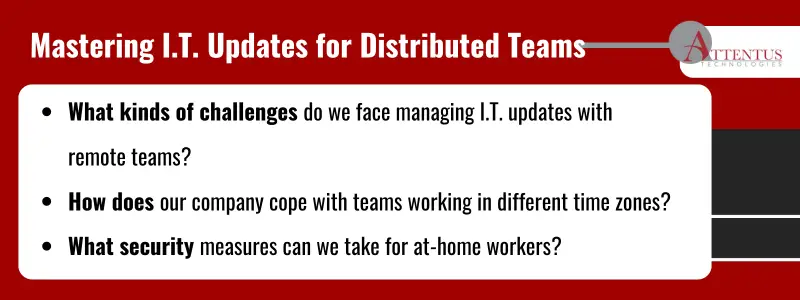To keep remote workforces operating safely and efficiently, your company needs to know how to handle I.T. updates properly

Working with distributed teams can provide businesses with many advantages, but can also pose challenges. Effectively managing I.T. updates for distributed teams is of the utmost importance to ensure the smooth running of operations, keeping disruptions to a minimum, and making your network secure.
I.T. can span a full range of services, such as:
- Network security
- Cloud services
- Help desk support
- Hardware support
- Network monitoring
- Data backup and recovery
- And many others
So, it is essential to master I.T. updates for distributed teams, handling everything from communicating more effectively to learning how to work across time zones.
Challenges of doing I.T. updates for distributed teams
Distributed teams offer several benefits to businesses, including the ability to have projects worked on around the clock by teams in different time zones, reduced office space needs, and access to top talent in regions with lower labor costs.
And the ability to work from home appeals to many people who appreciate achieving a work-life balance, replacing long commutes.
The challenges this setup faces include:
- Difficulties working across time zones
- Building rapport during remote working hours
- Scheduling meetings and one-on-one calls when people are only online at the same time for a few hours
- Collaboration among teams with different ways of working
How to better manage remote workers
When managing teams in different locations that often connect via video conferencing, it’s crucial to set clear expectations regarding:
- Attending team meetings that accommodate everyone’s schedule
- Deciding the communication channels everyone will use
- Building clear workflows that keep everyone on track
It is also essential to hold everyone accountable. While every team member needs to be given the freedom to do their work properly, they should also be guided by clear expectations about what they need to deliver and how they work with others.
Your remote workforce should also use the technology available to perform their jobs better. Synchronized project management tools and real-time document editing, for example, can connect teams worldwide. Social media platforms, professional networking sites, and virtual event technologies can help remote workers stay connected and collaborate with one another, industry peers, and industry thought leaders.
The Harvard Business Review points out that great remote work requires great remote work managers as well. Employees want “their managers to be present, hands-on, and operationally vigilant without being intrusive. In other words, employees don’t want their managers to micromanage them; they want their managers to micro-understand their work.”
Keep distributed teams safe
Keeping networks and private information safe is a big concern today, especially when dealing with distributed workforces. Security strategies might include:
- Using private, secure internet connections (as opposed to public WI-FI)
- Setting up virtual private networks (VPNs)
- Ensuring all software, including security packages, is up to date
- Establishing an incident response plan
- Educating everyone about security protocols
- Encrypting sensitive data
- Regularly backing up information
- Proper password management
Handling I.T. outage updates
Following the global I.T. outage caused by CrowdStrike, which affected millions of Windows users, properly handling outage updates has become an essential concern for many enterprises.
The World Economic Forum points out that the U.S. infrastructure is particularly vulnerable to cyberattacks, with state institutions, educational institutions, and corporations also frequent targets.
Not only do companies have to handle their own network outages, they must also deal with problems that remote workers have with internet and power failures at home. So, communication must flow both ways to keep teams and management updated about outages, how they are being addressed, and when things will return to normal.
You might then have specific protocols for home-user problems. If an employee is having internet speed problems, for example, check first that the slowdown isn’t the result of a high-traffic problem on applications such as Zoom.
Or you might consider subsidizing a worker’s cellular plan, so they have backup in case of a power or internet outage, using a hotspot for their computer connection.
You might also set up a written I.T. help protocol so workers know what things to check if they are having problems with their equipment.
Working across time zones
Effective management and flexibility are crucial for remote teams working across time zones. Establish everyone’s time zone and working hours, and consider rotating meeting times to avoid consistently inconveniencing the same team members. Utilize asynchronous communication channels to keep projects moving forward, even when teams are offline. Plan ahead for time zone differences, set clear expectations, and ensure well-communicated deadlines.
While meetings are valuable, assess if each is truly necessary—sometimes, an email can suffice, saving time and reducing scheduling conflicts.
Another great way to connect teams in disparate locations is through face-to-face interactions, whether through video calls or in-person meetings. These interactions are essential for team rapport and effective collaboration. Encourage one-on-one video sessions to foster personal connections and allow team members to bond in a more casual setting, such as virtual coffee breaks, enhancing teamwork and communication.
The most effective way to manage a distributed team
One of the best ways to ensure that you can master I.T. updates for a distributed team is to have a managed services partner such as Attentus Technologies. We are the Pacific Northwest’s leading provider of I.T. services.
We will work hard with you to develop the strategy and structure to manage remote teams better and facilitate their work. We truly believe that one of the best ways to promote team spirit is to have fun—one of our core values— creating an atmosphere where people are encouraged to laugh at themselves and with one another.
Contact us to learn how we can help make communicating I.T. updates to remote workers both powerful and enjoyable.
